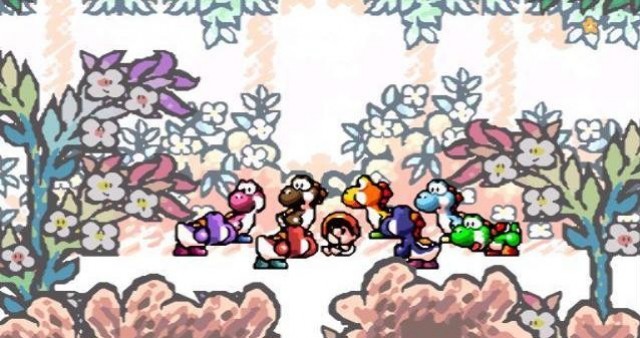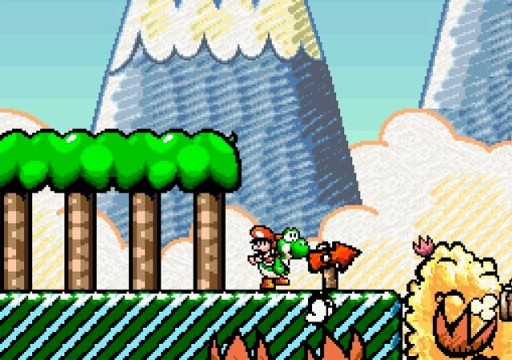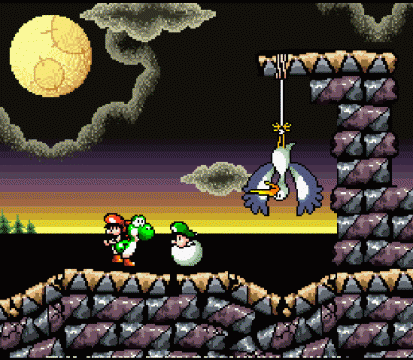
Super Mario World 2: Yoshi’s Island is as close to perfect as a platformer can get. Billed as the “sequel” to Super Mario World in the west, Yoshi’s Island is in reality a standalone game that was meant to propel the titular dinosaur into solo-stardom. It worked, but there are a number of fans the world over who will argue that Nintendo’s been chasing the ghost of this particular game with each subsequent trip back to the isle of dinos and babies. Nintendo has gotten close to recreating the joy of Yoshi’s Island, but from Yoshi’s New Island to Yoshi’s Story, not a single title has been able to recapture the wonder and quality of the original. What is it, though, that separates Yoshi’s Island from all of its descendants? It’s not just Kamek, egg throwing, and a litany of Shy Guys that make a proper Yoshi game– read on to find out what really made this title tick!

The Visuals
It’s impossible not to notice the unique visual style of Yoshi’s Island the second it’s booted up. Much has been said about the Super FX Chip, a special coprocessor that powered the visuals of such games as Star Fox, Stunt Race FX, and Yoshi’s Island, and the reason is because it helped yield some of the most spectacular graphics ever seen on SNES. Yoshi’s Island differentiated itself from those two previous games, however, by taking a subtler approach with the visuals-boosting chip. Donkey Kong Country had set a new milestone for home consoles with its lush, pre-rendered graphics, and then-Nintendo President Hiroshi Yamauchi wanted Yoshi’s Island to be comparable in terms of its visuals. He was so adamant about this that he told designer Shigeru Miyamoto the current build of Yoshi’s Island wasn’t up to the new standard and to take the whole game back to the drawing board to get its graphics up to snuff!
Rather than use the Super FX Chip to turn Yoshi’s Island into a 3D-fest along the lines of Star Fox or Donkey Kong Country, Miyamoto and company instead went in an entirely different direction. Yoshi’s Island has a hand drawn look that appears as though it was ripped straight from a coloring book, though not any one that a kid with a box of crayons could ever hope to produce. Everything on the screen is rendered in a rough, thickly outlined style, with bold, bright colors to match. Using the chip, the design team was able to rotate and blow up enemies to enormous size, as well as support all of the action taking place without skipping a beat. Levels like Lake Shore Paradise, The Cave of the Mystery Maze, and Raphael the Raven’s Castle (to name a few) are stunningly realized, and have burned themselves into my memories a lot more readily than some of today’s samey-looking HD affairs– or even anything from Yoshi’s last couple of games on superior hardware.
A particular standout, though, has to be Touch Fuzzy, Get Dizzy. The level has gotten a ton of attention over the years because of Yoshi’s seemingly… inebriated state after touching the nominal “Fuzzies,” but the resulting gimmick of a warping and twisting landscape is incredibly clever. The ground beneath Yoshi’s feet begins stretching and changing with every step until the effect of the Fuzzy wears off, making it incredibly difficult to move forward and not get hurt– or killed! Powered by the Super FX Chip, it’s a perfect example of how Yoshi’s Island was more concerned with using the coprocessor to implement a specific art direction over shooting for raw, graphical horsepower.
The Music
I don’t think I’m alone in saying that Yoshi’s Island is one of composer Koji Kondo’s greatest scores. Yoshi is inexorably tied to the Super Mario franchise, but how Kondo was able to produce an entire soundtrack that evokes the Mushroom Kingdom while simultaneously establishing a distinct sound for the dinosaur is beyond me. Tracks like Athletic, Underground, and Castle & Fortress have woefully utilitarian names, but thankfully sound far more lively than their titles would ever suggest. These are some classic, unforgettable Nintendo tunes that deserve as much praise as the overworld theme in Super Mario Bros. or The Legend of Zelda. The pieces are arranged with such delicate precision, each note perfectly complementing the stage a given song is found in. Listening to Yoshi’s Island is much a part of the experience as watching and playing it. As far as I’m concerned, not a single Yoshi game since has produced a soundtrack as wonderful as this one, and it’s a big part of the reason that those titles underwhelm.

The Controls
The control scheme in Yoshi’s Island is yet more proof positive that Nintendo simply “gets” game design in a way that other developers don’t. Yoshi’s move set is varied and engaging, with his signature flutter jump providing a nice safety net for less skilled players, and his arching targeting reticule allowing for both ease of use and the facilitation of trick shots for advanced players (with the aid of the game’s excellent ricochet physics, naturally). Of course, just gulping an enemy using Yoshi’s tongue is straightforward fun, too. It’s a might more complex than Super Mario Bros., but the controls remain intuitive and easy to learn, and like all the best Nintendo games do, Yoshi’s Island slowly teaches players the basics throughout the course of the adventure.
The Challenge
Yoshi’s Island came out in a time when Nintendo wasn’t as hyper-obsessed with making all of its games “accessible” (as though accessible can really be quantified anyway, but I digress). Yoshi’s Island is merciless. It’s not unfair, it’s not poorly balanced; it simply asks the player to learn its controls and step up to its challenge. There are no super blocks that’ll pop up and turn Yoshi into a ten foot tall war machine if the player dies too many times in a row. Instead, there are message blocks that provide helpful insight about how to make the most of Yoshi’s skills, and they can (gasp!) be ignored if the player is good to go on their own. I think sometimes that Nintendo forgets how it built its empire producing games that threw players into the wild and told them to figure out how to get the job done themselves (hello, Metroid!). It’s more pragmatic to meet players halfway, though, and Yoshi’s Island does just that: it’ll hold the player’s hand as much as the player wants it to.
Anyone who has yet to play Yoshi’s Island should head to the Wii U eShop, search the Virtual Console listings for Super Mario Advance 3: Yoshi’s Island, and give it a download. It’s not as impressive as the SNES original, but played on the GamePad this GBA port is still a good way to get to know one of the most classic titles in Nintendo’s catalog. I have high hopes for Yoshi’s Woolly World, but it’s going to take a heck of a lot for it to dethrone Yoshi’s Island as king.




 ShareThis
ShareThis







To this day no other Yoshi game has come to the SNES one. Not one yet. I’m still getting Yoshi’s Woolly World though. It looks like it will be a decent title if the reviews are anything to go by.
Yoshi’s Island is something else all right. Flawless, until you get hit and … that sound, you know the one, starts happening. *shiver*
…Was this the first game in which Mario had a voice? :^S
Good point about the getting hit thing. Now I can’t get the sound out of my head! Perhaps it was the first game where Mario had a “voice”. Pretty much Mario got a voice in Mario 64, I think. As far as that went anyway.